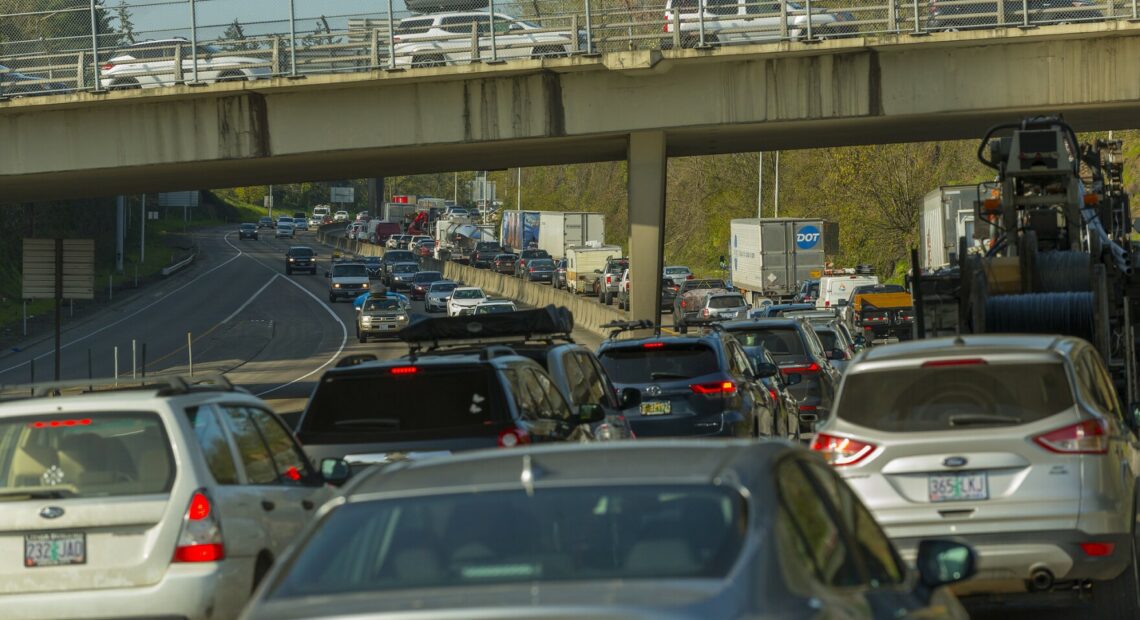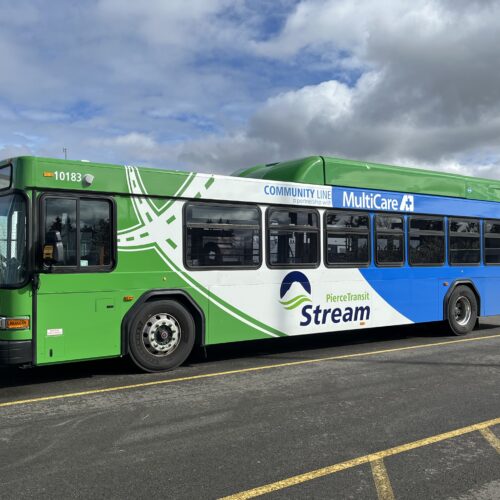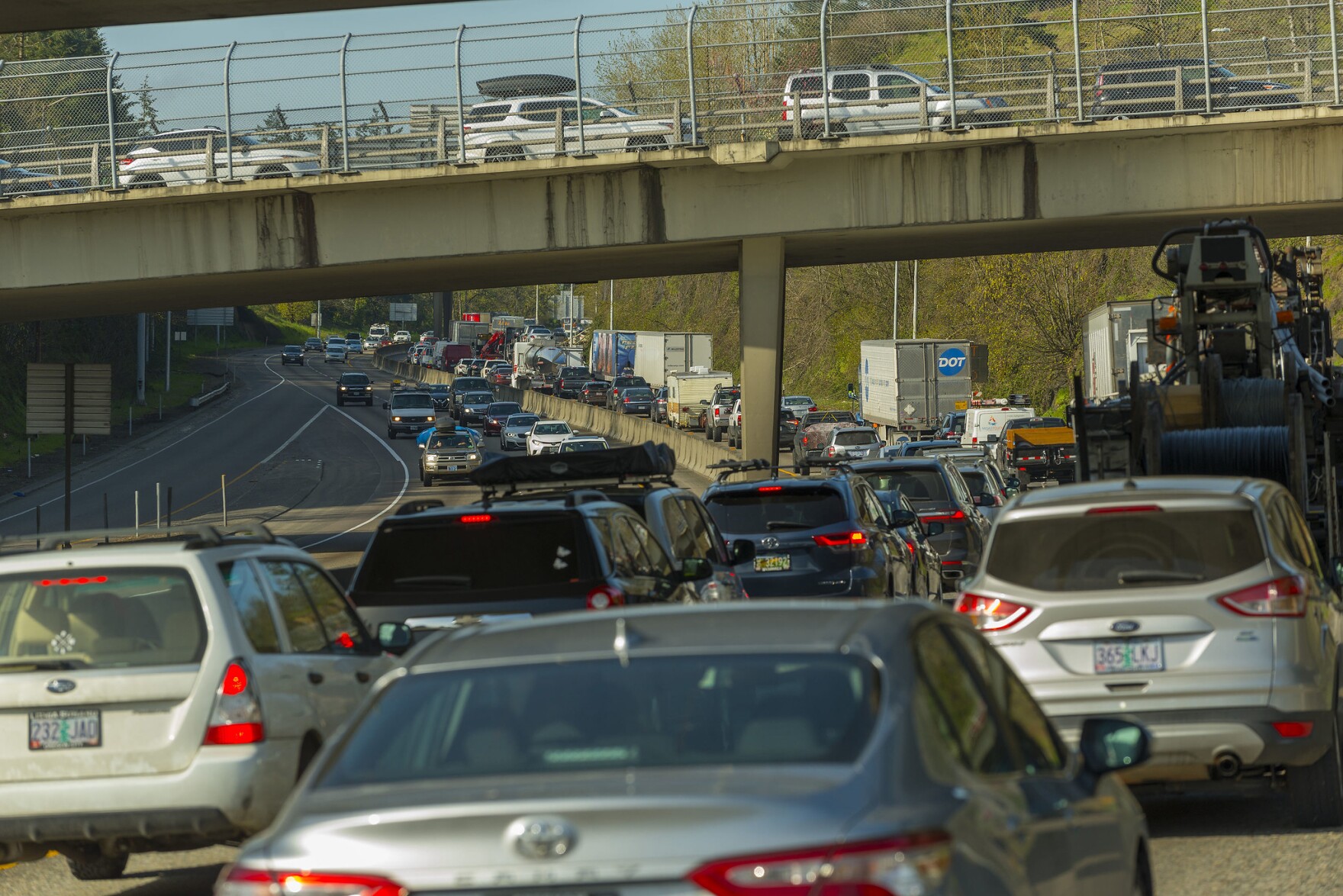
Highway Traffic Has Almost Returned To Pre-Pandemic Levels, But Transit Still Way Down
Read
You’re not imagining things if driving in Pacific Northwest traffic feels as busy these days as it was before the pandemic. Traffic data from the Oregon and Washington transportation departments show highway volumes are nearly back to 2019 levels.
Traffic monitored around the clock at 32 locations statewide by WSDOT during November 2021 was down four percent on average from the comparable period in 2019. Automatic traffic recorders at 38 locations across Oregon showed similar trends, with some places getting fully back to “normal” in some weeks as of this summer.
“In general, volumes are higher than last year and becoming very close to 2019 levels,” wrote ODOT senior economist Becky Knudson in a COVID-19 monitoring report. “However, volumes in the urban areas are relatively lower than the more rural areas.”
Daily traffic on Portland freeways is approaching pre-pandemic levels — 88 to 95 percent of 2019 daily traffic volumes, an ODOT spokesperson added.
So, what gives? The pandemic is ongoing and many people are still working from home. University of Washington expert Mark Hallenbeck, director of the Washington State Transportation Center, said part of the answer is that transit and carpool usage remains depressed.
“There’s been a reluctance to go back to crowded transit conditions,” Hallenbeck said in an interview. “It’s easier to hop in your car and go ahead and drive. It makes you feel safer.”
Another reason for single-occupant cars to crowd the roads comes from the difficulty of syncing carpool schedules with newly popular hybrid schedules where people work from home part-time.
“It’s really hard to carpool or vanpool when I’m working Tuesdays and Thursdays and you’re working (in the office) Mondays and Wednesdays,” Hallenbeck said. “So, that car pool doesn’t exist anymore.”
The ten biggest transit agencies in Washington state carried 40 to 50 percent fewer passengers on weekdays as of late summer than they did pre-pandemic, according to a WSDOT public transportation data dashboard. Ridership on Amtrak Cascades regional trains this autumn is down even more, around 60 percent below 2019.
The state-supported Amtrak Cascades service is slowly adding back trains to help ridership recover. Three roundtrips currently run between Seattle and Portland and there are two daily roundtrips on the Portland to Eugene segment. Amtrak Cascades passenger service north of Seattle to Vancouver, Canada, remains suspended.
From his office perch in a high rise in Seattle’s University District, Hallenbeck can see southbound Interstate 5 choke up almost every afternoon. He observed that a dearth of central business district workers returning to their offices is leading traffic demand to come back unevenly.
“The biggest difference is that a.m. peak periods don’t appear to be quite as strong as they used to be,” Hallenbeck said. “The afternoon is much closer.”
He said people who are working from home commonly go out in the afternoon to run errands and then mix with commuters to tip the freeway into a congested state.
Portland area freeways are showing the same morning-easier-than-afternoon pandemic travel pattern as Seattle, according to ODOT.
Hallenbeck said he is keeping an eye on the future of remote work and evolving hybrid work arrangements to anticipate what may happen next with traffic demand.
“Nobody really knows that answer,” he said. “I actually spend as much time reading the business journals as I spend reading the transportation journals.”
Related Stories:

Decades-long Highway 12 expansion sees ‘light at the end of the tunnel’
The decades-long project to widen Highway 12 between Burbank and Walla Walla has received a large grant that could lead to its completion. (Credit: Washington State Department of Transportation) Listen

Service changes begin March 31 for Pierce Transit, lack of funding means no new routes
This weekend, big service changes will go into effect for Pierce County’s public transportation system.
While Pierce Transit makes service changes throughout the year, Rebecca Japhet, who handles communications for the public transit operator, said these service changes are the biggest the company has made in seven years.

Mr. WSDOT — the man who’s helped make road alerts interesting and ‘artistic’ — is heading to a new job
When Mike Allende started managing social media for the Washington State Department of Transportation, he was told “don’t be boring.”
“Boring” is probably the last word any one would use to describe Allende’s approach to the job, which massively grew engagement while he worked there. Known by some fans as Mr. WSDOT, he’s the man behind the most followed state department of transportation Twitter, or X, account nationwide, with some 543,000 followers on the department’s traffic page.
















